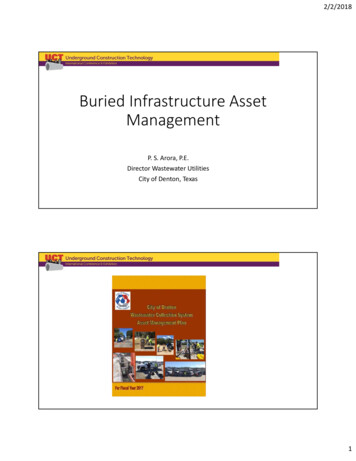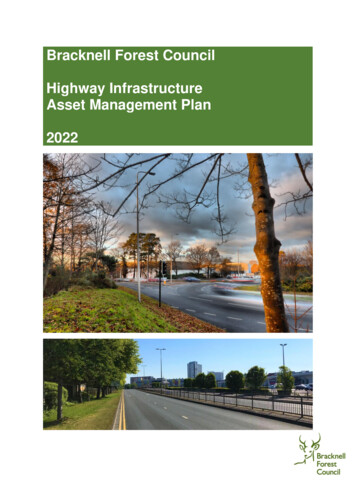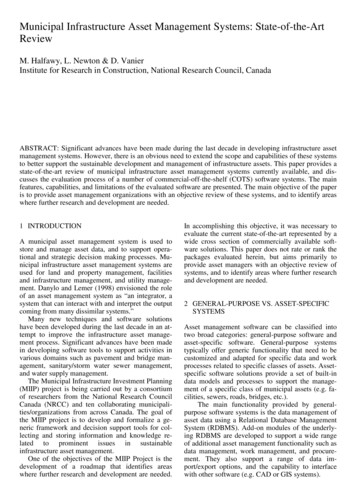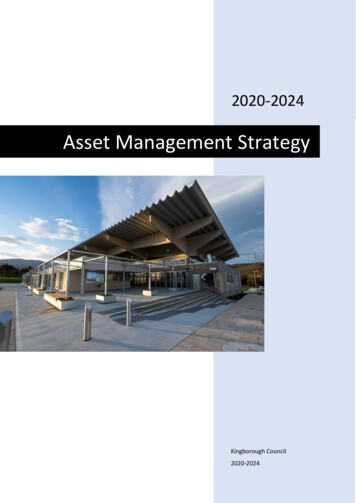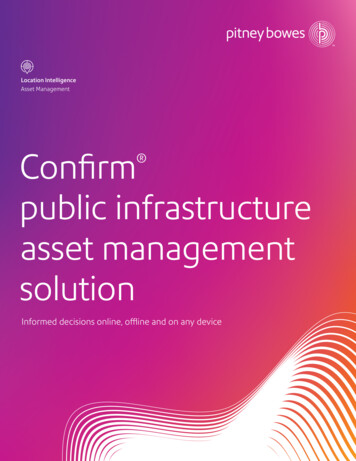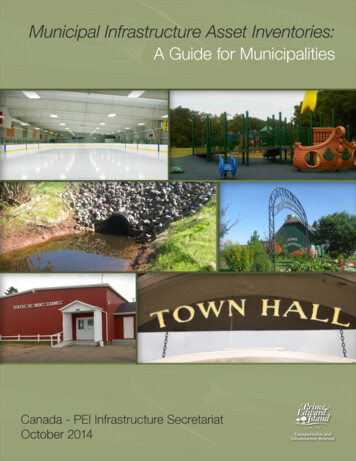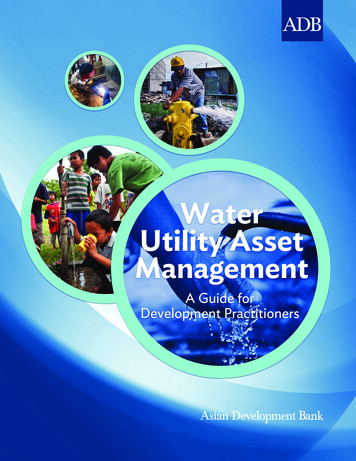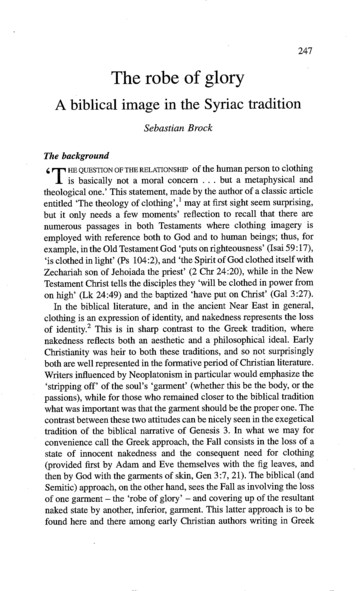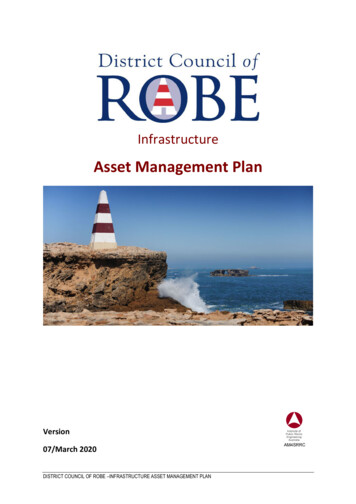
Transcription
InfrastructureAsset Management PlanVersion07/March 2020DISTRICT COUNCIL OF ROBE –INFRASTRUCTURE ASSET MANAGEMENT PLAN
Asset Management for Small, Rural or Remote CommunitiesDocument ControlDocument ID: 59 280 111111 am4srrc amp word template v10.5Rev NoDateRevision opted by CouncilVMNB3Oct – 17DraftVMNB420/03/18Adopted by CouncilVMNBCouncil5May – 19Adopted by CouncilVMNBCouncil6Dec 19DraftVMNB711/03/20Adopted by CouncilVMNBAsset Management for Small, Rural or Remote Communities Practice NoteThe Institute of Public Works Engineering Australia.www.ipwea.org.au/AM4SRRC Copyright 2011 – All rights reserved.DISTRICT COUNCIL OF ROBE INFRASTRUCTURE ASSET MANAGEMENT PLANApproverCouncilCouncil
-i-TABLE OF CONTENTS1.EXECUTIVE SUMMARY . iii2.INTRODUCTION . 12.1Background . 12.2Goals and Objectives of Asset Management . 12.3Plan Framework . 22.4Core and Advanced Asset Management . 32.5Community Consultation . 33. LEVELS OF SERVICE . 33.1Customer Research and Expectations . 33.2Legislative Requirements . 33.3Current Levels of Service . 33.4Desired Levels of Service . 54. FUTURE DEMAND . 54.1Demand Forecast . 54.2Changes in Technology. 64.3Demand Management Plan . 64.4New Assets from Growth . 65. LIFECYCLE MANAGEMENT PLAN . 75.1Background Data . 75.2Risk Management Plan . 85.3Routine Maintenance Plan . 95.4Renewal/Replacement Plan . 105.5Creation/Acquisition/Upgrade Plan . 125.6Disposal Plan . 136. FINANCIAL SUMMARY . 136.1Financial Statements and Projections . 136.2Funding Strategy . 176.3Valuation Forecasts . 176.4Key Assumptions made in Financial Forecasts . 187. ASSET MANAGEMENT PRACTICES . 187.1Accounting/Financial Systems. 187.2Asset Management Systems . 197.3Information Flow Requirements and Processes . 197.4Standards and Guidelines . 208. PLAN IMPROVEMENT AND MONITORING . 2008.1Performance Measures . 2008.2Improvement Plan. 2008.3Monitoring and Review Procedures . 21REFERENCES. 211APPENDICES . 211Appendix A Maintenance Response Levels of Service . 222Appendix B Projected 10 year Capital Renewal Works Program . 233Appendix C Planned Upgrade/Exp/New 10 year Capital Works Program . 266Appendix D Abbreviations . 277Appendix E Glossary . 288DISTRICT COUNCIL OF ROBE –INFRASTRUCTURE ASSET MANAGEMENT PLAN
- ii -This page is left intentionally blank.DISTRICT COUNCIL OF ROBE INFRASTRUCTURE ASSET MANAGEMENT PLAN
- iii -1.EXECUTIVE SUMMARYWhat we will doContextThe District Council of Robe is situated on GuichenBay, about 350km south east of Adelaide. Robe has apopulation of approximately 1,400 people in wintermonths, with an influx of 15,000 people everysummer.Council has ageing infrastructure and in particular theroad network and marina infrastructure needsmaintenance, renewal and upgrading.The Infrastructure ServiceThe infrastructure network comprises: Sealed & unsealed roads Kerbing Bridges Footpaths Stormwater drainage Marina CommunityWastewaterSystem (CWMS)Council plans to provide operation, maintenance,renewal and upgrade of infrastructure service assetsto meet service levels set by council in annual budgetswithin the 10 year planning period.What we cannot doCouncil does not have enough funding to provide allservices at the desired service levels or provide newservices.Managing the RisksManagementWhat does it Cost?The projected cost to provide the services covered bythis Asset Management Plan includes operations,maintenance, renewal and upgrade of existing assetsover the 10 year planning period is 27,632,000 or 2,763,000 per year.Council’s estimated available funding for this period is 27,583,000 or 2,758,000 per year which is 100% ofthe cost to provide the service. This is a fundingshortfall of 5,000 per year. Projected and budgetedexpenditure are shown in the graph below.There are risks associated with providing the serviceand not being able to complete all identified activitiesand projects. We have identified major risks as: Insufficient resources including funding and staffto replace/renew assets in accordance withrenewal forecasts. Incomplete/inaccurate asset data, particularly thecondition of the road, marina and commoneffluent assets.We will endeavour to manage these risks withinavailable funding by: Conducting regular condition assessments andsite inspections to determine the remaining usefullife of assets and maintenance requirements. Request funding for renewals as required andmonitor trends of maintenance. Seeking grant funds and/or State Governmentsupport.The Next StepsThe actions resulting from this asset management planare: Continue to improvement the data in relation tocondition assessments of infrastructure assets. Use the condition assessments of infrastructureassets to better determine the remaining usefullife.Council’s’ present funding levels are sufficient tocontinue to provide existing services at current levelsin the medium term.DISTRICT COUNCIL OF ROBE INFRASTRUCTURE ASSET MANAGEMENT PLAN
- iv -Questions you may have6.What is this plan about?This asset management plan covers the infrastructureassets that serve the Robe Community’s transportneeds. These assets include Roads, Bridges, Footways,Stormwater Drainage, Marina Development andCWMS throughout the Council area that enablepeople to get to work and recreation, children to getto school, farm produce to markets and goods andservices to shops.What is an Asset Management Plan?Asset management planning is a comprehensiveprocess to ensure delivery of services frominfrastructure is provided in a financially sustainablemanner.An asset management plan details information aboutinfrastructure assets including actions required toprovide an agreed level of service in the most costeffective manner. The Plan defines the services to beprovided, how the services are provided and whatfunds are required to provide the services.7.8.What happens if we don’t manage the shortfall?It is likely that council will have to reduce service levelsin some areas, unless new sources of revenue arefound. For transport infrastructure, the service levelreduction may include loss of all-weather access for anumber of unsealed roads and increase in footpathtrip hazards and bridges with load limits.What can we do?Council can develop options and priorities for futuretransport services with costs of providing the services,consult with the community to plan future services tomatch the community services needs with ability topay for services and maximise benefit to thecommunity for costs to the community.Why is there a funding shortfall?Most of the Council’s transport network wasconstructed from government grants often providedand accepted without consideration of ongoingoperations, maintenance and replacement needs.Consulting with the community to ensure thattransport services and costs meet communityneeds and are affordable,Developing partnership with other bodies, whereavailable to provide services,Seeking additional funding from governments andother bodies to better reflect a ‘whole ofgovernment’ funding approach to infrastructureservices.Many of these assets are approaching the later yearsof their life and require replacement, services from theassets are decreasing and maintenance costs areincreasing.Council’s’ present funding levels are insufficient tocontinue to provide existing services at current levelsin the medium term.What options do we have?Resolving the funding shortfall involves several steps:1. Improving asset knowledge so that dataaccurately records the asset inventory, how assetsare performing and when assets are not able toprovide the required service levels,2. Improvingourefficiencyinoperating,maintaining, replacing existing and constructingnew assets to optimise life cycle costs,3. Identifying and managing risks associated withproviding services from infrastructure,4. Making tradeoffs between service levels and coststo ensure that the community receives the bestreturn from infrastructure,5. Indentifying assets surplus to needs for disposal tomake saving in future operations andmaintenance costs,DISTRICT COUNCIL OF ROBE INFRASTRUCTURE ASSET MANAGEMENT PLAN
-1-2.INTRODUCTION2.1BackgroundThis asset management plan is to demonstrate responsive management of assets (and services provided from assets),compliance with regulatory requirements, and to communicate funding needed to provide the required levels ofservice.The asset management plan is to be read with Council’s Asset Management Policy, Asset Management Strategy andthe following associated planning documents: Community Plan 2019-2039District Council of Robe Long Term Financial Plan 2020-2029Development PlanAnnual BudgetThis infrastructure assets covered by this asset management plan are shown in Table 2.1.Table 2.1: Assets covered by this PlanAsset category2.2Replacement ValueRoad Assets 77,512,000Bridges 134,000Footpaths 1,010,000Stormwater Drainage 2,339,000Marina Development 3,826,000CWMS 10,565,000TOTAL 95,386,000Goals and Objectives of Asset ManagementThe Council exists to provide services to its community. Some of these services are provided by infrastructure assets.Council has acquired infrastructure assets by ‘purchase’, by contract, construction by council staff and by donation ofassets constructed by developers and others to meet increased levels of service.Council’s goal in managing infrastructure assets is to meet the required level of service in the most cost effectivemanner for present and future consumers. The key elements of infrastructure asset management are: Taking a life cycle approach,Developing cost-effective management strategies for the long term,Providing a defined level of service and monitoring performance,Understanding and meeting the demands of growth through demand management and infrastructureinvestment,Managing risks associated with asset failures,Sustainable use of physical resources,Continuous improvement in asset management practices.1The goal of this asset management plan is to: 1Document the services/service levels to be provided and the costs of providing the service,Communicate the consequences for service levels and risk, where desired funding is not available, andProvide information to assist decision makers in trading off service levels, costs and risks to provideservices in a financially sustainable manner.IPWEA, 2006, IIMM Sec 1.1.3, p 1.3.DISTRICT COUNCIL OF ROBE INFRASTRUCTURE ASSET MANAGEMENT PLAN
-2-This asset management plan is prepared under the direction of Council’s vision, mission, goals and objectives.Council’s vision is:The District Council of Robe will be a sustainable, vibrant, harmonious and prosperous place to live, work & visit.Council’s mission is:The District Council of Robe will achieve its vision by; Working with our community to meet its aspirations Building a sense of community Maintaining our built and natural environments Providing strong leadership and prudent stewardship Meeting our legislative responsibilities Delivering projects and services within a sound financial framework and aligned with out agreed roles.Relevant goals and objectives and how these are addressed in this asset management plan are shown in Table 2.2.Table 2.2: Organisation GoalsGoalGovernanceandFinancial sustainability– Provide effective andinspiredleadership,good governance andefficient, effective andresponsiveCouncilservicesObjective 2.3Provide effective leadershipand good governanceEngage effectively with ourcommunityBe Financially sustainableMaintain effective andtransparent business systemsEnsure that out skilled,professional staff operate in asupportive and accountableenvironment.How Goal and Objectives are addressed in AMPThis asset management plan documents thestrategies and funding levels for asset replacement,renewal & upgrades over the long-term to ensurethe ongoing financial sustainability of the Council.Plan FrameworkKey elements of the plan are Levels of service – specifies the services and levels of service to be provided by council.Future demand – how this will impact on future service delivery and how this is to be met.Life cycle management – how the organisation will manage its existing and future assets to provide therequired servicesFinancial summary – what funds are required to provide the required services.Asset management practicesMonitoring – how the plan will be monitored to ensure it is meeting the organisation’s objectives.Asset management improvement planDISTRICT COUNCIL OF ROBE INFRASTRUCTURE ASSET MANAGEMENT PLAN
-3-2.4Core and Advanced Asset ManagementThis asset management plan is prepared as a first cut ‘core’ asset management plan in accordance with theInternational Infrastructure Management Manual2. It is prepared to meet minimum legislative and organisationalrequirements for sustainable service delivery and long term financial planning and reporting. Core asset managementis a ‘top down’ approach where analysis is applied at the ‘system’ or ‘network’ level.2.5Community ConsultationThis ‘core’ asset management plan is prepared to facilitate community consultation initially through feedback onpublic display of draft asset management plans prior to adoption by Council. Future revisions of the assetmanagement plan will incorporate community consultation on service levels and costs of providing the service. Thiswill assist Council and the community in matching the level of service needed by the community, service risks andconsequences with the community’s ability to pay for the service.3.LEVELS OF SERVICE3.1Customer Research and ExpectationsCouncil has not carried out any research on customer expectations. This will be investigated for future updates of theasset management plan.3.2Legislative RequirementsCouncil has to meet many legislative requirements including Australian and State legislation and State regulations.Relevant legislation is shown in Table 3.2.Table 3.2: Legislative RequirementsLegislationRequirementLocal Government ActLocalGovernmentManagementandAmendment Act 2005Sets out role, purpose, responsibilities and powers of local governmentsincluding the preparation of a long term financial plan supported by assetmanagement plans for sustainable service delivery.(FinancialRating)Impetus for the development of a Strategic Management Plan, comprisingan (Infrastructure) Asset Management Plan and Long-term Financial PlanEnvironmental Protection Act 1993This Act places a ‘duty of care’ on people not to undertake activities thatwill cause environmental harm.Work Health and Safety Act 2012An Act to provide for the health, safety and welfare of persons at work.Development Act 1993An Act to provide for planning and regulate development in the State; toregulate the use and management of land and buildings; to make provisionfor the maintenance and conservation of land and buildings whereappropriate; and for other purposes.Australian Accounting StandardsSets out the financial reporting standards for the (re)valuation anddepreciation of assets3.3Current Levels of ServiceCouncil has defined service levels in two terms.2IPWEA, 2006.DISTRICT COUNCIL OF ROBE INFRASTRUCTURE ASSET MANAGEMENT PLAN
-4-Community Levels of Service relate to the service outcomes that the community wants in terms of safety, quality,quantity, reliability, responsiveness, cost effectiveness and legislative compliance.Community levels of service measures used in the asset management plan are:QualityFunctionSafetyHow good is the service?Does it meet users’ needs?Is the service safe?Technical Levels of Service - Supporting the community service levels are operational or technical measures ofperformance. These technical measures relate to the allocation of resources to service activities that the councilundertakes to best achieve the desired community outcomes.Technical service measures are linked to annual budgets covering: Operations – the regular activities to provide services such as opening hours, cleansing frequency, mowingfrequency, etc.Maintenance – the activities necessary to retain an assets as near as practicable to its original condition (egroad patching, unsealed road grading, building and structure repairs),Renewal – the activities that return the service capability of an asset up to that which it had originally (egfrequency and cost of road resurfacing and pavement reconstruction, pipeline replacement and buildingcomponent replacement),Upgrade – the activities to provide an higher level of service (eg widening a road, sealing an unsealed road,replacing a pipeline with a larger size) or a new service that did not exist previously (eg a new library).Council’s current service levels are detailed in Table 3.3.Table 3.3: Current Service LevelsKeyPerformanceMeasureLevel of ServiceObjectivePerformanceMeasure ProcessDesired Level ofServiceCurrent Level of ServiceCOMMUNITY LEVELS OF SERVICEQualityWell maintained andsuitable sealed roadnetworkCustomer requestsrelating to maintenanceLess than 5 per yearCustomer requests arerecorded however a formalsystem needs to be set upand resources need to beallocated to accuratelymeasure requests relatingto maintenanceQualityWell maintained andsuitable unsealed roadnetworkCustomer requestsrelating to maintenanceLess than 5 per yearCustomer requests arerecorded however a formalsystem needs to be set upand resources need to beallocated to accuratelymeasure requests relatingto maintenanceNumber of patrolgrades per yearQualityWell maintained andsuitable kerbing,bridges, footpaths &stormwater drainsCustomer requestsrelating to maintenanceLess than 5 per yearCustomer requests arerecorded however a formalsystem needs to be set upand resources need to beallocated to accuratelymeasure requests relatingto maintenanceQualityWell maintained andsuitable marinaCustomer requestsrelating to maintenanceLess than 5 per yearCustomer requests arerecorded however a formalsystem needs to be set upand resources need to beDISTRICT COUNCIL OF ROBE INFRASTRUCTURE ASSET MANAGEMENT PLAN
-5-allocated to accuratelymeasure requests relatingto maintenanceQualityWell maintained andsuitable CWMSCustomer requestsrelating to maintenanceLess than 5 per yearCustomer requests arerecorded however a formalsystem needs to be set upand resources need to beallocated to accuratelymeasure requests relatingto maintenanceFunctionAccess is available at alltimes for designatedinfrastructure assetsCustomer requestsrelating to non-accessLess than 5 per yearCustomer requests arerecorded however a formalsystem needs to be set upand resources need to beallocated to accuratelymeasure requests relatingto non-accessSafetyProvide safe suitableinfrastructure free fromhazardsNumber of Injuryand/or propertydamage claimsLess than 2 per yearNo claims in past yearTECHNICAL LEVELS OF SERVICEOperationsInfrastructure meetsusers’ needsNumber of complaintsMaintenance &renewal to beimplemented atoptimal times toachieve best value formoneyMaintenance and renewalwork is undertaken inaccordance with AnnualBusiness Plan allocationsand at optimal timesMaintenanceInfrastructure is wellmaintainedInspection programInfrastructuremaintenanceprogram meetscommunityexpectationsFurther resources need tobe allocated to develop andimplement a formalinspection andmaintenance programRenewalInfrastructure is safeand reliableAnnual renewalprogram is delivered ontime and within budgetRenewal ofinfrastructure thatthe community iswilling to accept andpay forCapital works program is ontargetUpgrade/NewInfrastructure issuitable for its purposeMonitor to determineupgrade requirementsInfrastructure meetsthe capacity andsafety requirementsof the communityConsultant engineerprovides practicalcompletion documentation3.4Desired Levels of ServiceAt present, indications of desired levels of service are obtained from various sources including residents’ feedback toCouncillors and staff, service requests and correspondence.4.FUTURE DEMAND4.1Demand ForecastFactors affecting demand include population change, changes in demographics, seasonal factors, consumerpreferences and expectations, economic factors, agricultural practices, environmental awareness, etc.Demand factor trends and impacts on service delivery are summarised in Table 4.1.DISTRICT COUNCIL OF ROBE INFRASTRUCTURE ASSET MANAGEMENT PLAN
-6-Table 4.1: Demand Factors, Projections and Impact on ServicesDemand factorPopulation4.2Present position1,400Projection 0.1%Impact on servicesNominalChanges in TechnologyTechnology changes are forecast to have little effect on the delivery of services covered by this plan.4.3Demand Management PlanDemand for new services will be managed through a combination of managing existing assets, upgrading of existingassets and providing new assets to meet demand and demand management. Demand management practices includenon-asset solutions, insuring against risks and managing failures.Non-asset solutions focus on providing the required service without the need for the council to own the assets.Examples of non-asset solutions include providing services from existing infrastructure such as aquatic centres andlibraries that may be in another council area or public toilets provided in commercial premises.There are no opportunities identified to date for demand management. Opportunities will be considered anddeveloped in future revisions of this asset management plan.4.4New Assets for GrowthThe new assets required to meet growth will be acquired free of cost from land developments andconstructed/acquired by Council. There are no additional substantial infrastructure assets resulting from growth overthe next ten years unless significant government funding becomes available. The new contributed and constructedasset values are summarised in Figure 1.Figure 1: New Assets for GrowthDISTRICT COUNCIL OF ROBE INFRASTRUCTURE ASSET MANAGEMENT PLAN
-7-Acquiring these new assets will commit council to fund ongoing operations and maintenance costs for the period thatthe service provided from the assets is required. These future costs are identified and considered in developingforecasts of future operations and maintenance costs.5.LIFECYCLE MANAGEMENT PLANThe lifecycle management plan details how Council plans to manage and operate the assets at the agreed levels ofservice (defined in Section 3) while optimising life cycle costs.5.1Background Data5.1.1Physical parametersThe assets covered by this asset management plan are shown in Table 2.1.Infrastructure assets are provided for the community throughout Robe. The majority of assets were constructed orreconstructed in their current forms from about the 1950’s and reconstructions continue to occur as required.Construction material for road pavements has generally been sourced from local limestone which also varies in qualityand durability. In addition to this, sub-base material (natural soil) varies considerably throughout the district impactingon the useful life of the pavement.Kerb and gutter was originally constructed using prefabricated concrete slabs while today it is constructed in-situ on acompacted based using a mechanical kerbing machine. Footpaths vary from natural surface, to paved and concreted.The changing construction standards and location of various assets provide variable service levels to residentsthroughout the community (for instance some farm accesses have all weather road access while others don’t).The aging infrastructure will increasingly see assets reach the end of their useful life and over the next 10 to 20 yearsand may exert higher than normal funding pressures. There has also been a substantial increase in traffic loads in thelast 50 years so some pavements (in particular key freight routes) do not meet current standards and will need to bereconstructed to a higher standard. This means the cost of reconstructing will be higher than the reportedreplacement cost.5.1.2Asset capacity and performanceCouncil’s services are generally provided to meet design standards where these are available.Locations where deficiencies in service performance are known are detailed in Table 5.1.2.Table 5.1.2: Known Service Performance DeficienciesLocationService DeficiencyRobeSome town sealed roads are suffering surface texture defects and could leadto pavement failure.RobeSome town roads have no kerbingRobeSome roads have no footpathsRobe marinaCondition assessments have highlighted the poor state of a number ofinfrastructure assets that could lead to infrastructure failureThe above service deficiencies were identified from inspections and engineering condition assessments5.1.3Asset conditionMarina asset condition information is available via GHD Robe Marina Condition Assessment Report (January 2015).DISTRICT COUNCIL OF ROBE INFRASTRUCTURE ASSET MANAGEMENT PLAN
-8-5.1.4Asset valuationsThe value of assets recorded in the asset register as at 30/06/201
DISTRICT COUNCIL OF ROBE INFRASTRUCTURE ASSET MANAGEMENT PLAN This asset management plan is prepared under the direction of Council's vision, mission, goals and objectives. Council's vision is: The District Council of Robe will be a sustainable, vibrant, harmonious and prosperous place to live, work & visit. Council's mission is:
